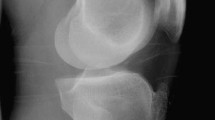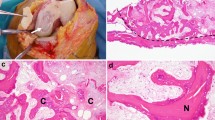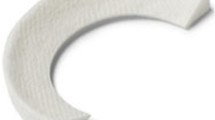Abstract
This paper presents a clinical and functional assessment of the cases of osteochondritis dissecans (OCD) treated with small mosaicplasty type osteochondral grafts. Between 1999 and 2004, we operated on 12 knees with OCD stages III and IV. They were assessed using the International Cartilage Research Society (ICRS) scale, the Visual Analogue Scale (VAS) scale, X-ray and magnetic resonance imaging (MRI). The study was carried out using a clinical series, was retrospective and had a level of evidence of 4. Before surgery, all patients were in classes III and IV on the ICRS scale (four in class III and eight in class IV). At the time of surgery, the patient age was 27.5 ± 7.9 years, with male predominance (75%). Eleven of the cases were assessed as classes I and II on the ICRS scale (seven in class I and four in class II), with one patient in class IV. X-ray assessment was less favourable, revealing alterations in the articular space in 75% of cases. The results show that this technique enables the biological fixation of fragments and, functionally, the clinical results obtained were very good. The osteochondral grafts avoid the implantation of foreign material and make use of bone fragments of the same rigidity as the OCD fragment. We conclude that the technique described is an excellent alternative to the techniques normally used for the fixation of stage III and IV OCD.
Résumé
Les auteurs présentent une évaluation clinique et fonctionnelle des malades avec ostéochondrite disséquante du genou (OCD) traitées avec des greffons osteochondrales (mosaicplasty-lie).Entre 1999 et 2004, nous avons opéré 12 genoux avec ostéochondrite disséquante (étage 3 et 4). Ils ont été évaluées en utilisant l’échelle d'ICRS, VAS, les radiographies et la résonance magnétique. Série clinique, rétrospectif, niveau de évidence 4.Avant la chirurgie, tous les malades étaient dans les groupes III et IV de l'échelle ICRS (4 á l’étage III ; 8 à IV). Au moment de la chirurgie, l'âge moyen était de ± 27.5 7.9 ans et prédominance masculine (75%). Au moment de la révision 11 des malades étaient dans les groupes I et II d'ICRS (7 I et 4 II), 1 malade dans le groupe IV. L'évaluation radiographique montrait altérations arthrosiques avec pincement d’interligne articulaire en 75% des cas.Cette technique permet la fixation biologique des fragments. Fonctionnellement, les résultats cliniques obtenus étaient très bons. Elle peut dispenser l'implantation d’autre matériel (un corp étranger) en même que les greffes de fixation présentent la même rigidité du fragment osteochondral.La technique décrite est une excellente alternative aux techniques normalement utilisées pour la fixation des Osteochondritis disséquantes dégrée III et IV.





Similar content being viewed by others
Notes
The cartilage standard evaluation form/knee. ICRS Newsletter, Spring 1998.
References
Aglietti P, Buzzi R, Bassi PB, Fioriti M (1994) Arthroscopic drilling in juvenile osteochondritis dissecans of the medial femoral condyle. Arthroscopy 10:286–291
Årøen A, Løken S, Heir S, Alvik E, Ekeland A, Granlund OG, Engebretsen L (2004) Articular cartilage lesions in 993 consecutive knee arthroscopies. Am J Sports Med 32:211–215
Bandi W, Allgoewer M (1959) On the therapy of osteochondritis dissecans (in German). Helv Chir Acta 26:552–558
Bedouelle J (1988) L’ostéochondrite disséquante des condyles fémoraux chez l’enfant et l’adolescent. In: Cahiers d’enseignement de la SOFCOT. Expansion Scientifique Française, Paris, France, pp 61–93
Berlet GC, Mascia A, Miniaci A (1999) Treatment of unstable osteochondritis dissecans lesions of the knee using autogenous osteochondral grafts (mosaicplasty). Arthroscopy 15:312–316
Cahill B (1995) Osteochondritis dissecans of the knee: treatment of juvenile and adult forms. J Am Acad Orthop Surg 3:237–247
Duchow J, Hess T, Kohn D (2000) Primary stability of press-fit-implanted osteochondral grafts. Influence of graft size, repeated insertion, and harvesting technique. Am J Sports Med 28:24–27
Hangödy L, Kish G, Karpati Z, Udvarhelyi I, Szigeti I, Bély M (1998) Mosaicplasty for the treatment of articular cartilage defects: application in clinical practice. Orthopedics 21:751–756
Hangödy L, Füles P (2003) Autologous osteochondral mosaicplasty for the treatment of full-thickness defects of weight-bearing joints. Ten years of experimental and clinical experience. J Bone J Surg Am 85:25–32
Jakob RP, Petek D (2003) Ostéochondrite disséquante du genou traité par la mosaicplasty. In: Cahiers d’enseignement de la SOFCOT. Expansion Scientifique Française, Paris, France, pp 15–30
Karataglis D, Learmonth DJ (2005) Management of big osteochondral defects of the knee using osteochondral allografts with the MEGA-OATS technique. Knee 12(5):389–393
Kazutomo M, Yasuyuki I, Eiichi T, Hideki S, Satoshi T (2007) Results of arthroscopic fixation of osteochondritis dissecans lesion of the knee with cylindrical autogenous osteochondral plugs. Am J Sports Med 35:216–222
Kobayashi T, Fujikawa K, Oohashi M (2004) Surgical fixation of massive osteochondritis dissecans lesion using cylindrical osteochondral plugs. Arthroscopy 20(9):981–986
Kocher MS, Tucker R, Ganley TJ, Flynn JM (2006) Management of osteochondritis dissecans of the knee. Current concepts review. Am J Sports Med 34(7):1181–1191
Lefort G (2006) Ostéochondrite disséquante des condyles fémoraux. In: Symposium de la SOFCOT 2005, suppl au no 5. Rev Chir Orthop 92(2):S99
Louisia S, Beaufils P, Katabi M, Robert H; French Society of Arthroscopy (2003) Transchondral drilling for osteochondritis dissecans of the medial condyle of the knee. Knee Surg Sports Traumatol Arthrosc 11(1):33–39
Makino A, Muscolo DL, Puiegdevall M, Costa-Paz M, Ayerza M (2005) Arthroscopic fixation of osteochondritis dissecans of the knee. Clinical, magnetic resonance imaging, and arthroscopic follow-up. Am J Sports Med 33(10):1499–1504
Outerbridge HK, Outerbridge RE, Smith DE (2000) Osteochondral defects in the knee: a treatment using lateral patella autografts. Clin Orthop 377:145–151
Pappas AM (1981) Osteochondrosis dissecans. Clin Orthop 158:59–69
Smillie IS (1957) Treatment of osteochondritis dissecans. J Bone Joint Surg Br 39:248–260
Tuompo P, Arvela V, Partio EK, Rokkanen P (1997) Osteochondritis dissecans of the knee fixed with biodegradable self-reinforced polyglycolide and polylactide rods in 24 patients. Int Orthop 21:355–360
Thomson NL (1987) Osteochondritis dissecans and osteochondral fragments managed by Herbert compression screw fixation. Clin Orthop Relat Res 224:71–78
Versier G, Breda R (2006) Traitement chirurgicale par fixation. Rev Chir Orthop 92:2S113–2S117
Wagner H (1964) Traitement opératoire de l’ostéochondrite disséquante, cause de l’arthrite déformante du genou. Rev Chir Orthop 50:335–352
Acknowledgement
The authors would like to thank Francisco Balacó for the interpretation and critical review of the statistical analysis.
Conflict of interest statement
There are no conflicts of interest of any of the authors.
Author information
Authors and Affiliations
Corresponding author
Rights and permissions
About this article
Cite this article
Fonseca, F., Balacó, I. Fixation with autogenous osteochondral grafts for the treatment of osteochondritis dissecans (stages III and IV). International Orthopaedics (SICO 33, 139–144 (2009). https://doi.org/10.1007/s00264-007-0454-2
Received:
Accepted:
Published:
Issue Date:
DOI: https://doi.org/10.1007/s00264-007-0454-2




